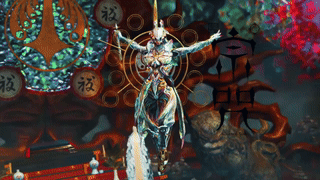After discovering that the director of Kunitsu-Gami was heavily inspired by folk-lore and finding Kunio Yanagita's work mentioned in the Mountain God Japanese wiki article, I decided to read a few stories.
Here is a link: The Yanagita Kunio Guide to the Japanese Folk Tale
Some of them remind me of how the Seethe backstories are written.
Noderabo, for example. It really has the vibe of a folk-lore story.
There once was a priest who enjoyed ringing the temple bell to lure in a colony of frogs. One day, a wounded warrior came to the temple with his pursuers in tow. The priest tried to hide the defeated warrior, but his lies were seen through and he was cut down. Frogs gathered around the fallen priest's form, and the rescued warrior shrouded him in his own armor.
Or Shiniku Zamurai...
There once was a samurai who swung his sword at all those in his path, regardless of friend or foe. His life came to an end one night when he was taken down in his sleep. Legend says the corpse left behind was merely a collection of faces, with no way to tell which one was the true face of the samurai. Even in death the samurai's lust for blood is unyielding, and it can be found roaming the mountains at night, a sword pulled from its own head in hand.
Mukadejoro...
Long ago, there was a woman who lived in a cave. According to legend, all those who laid eyes on her would soon find their fields infested with plagues of insects. As time passed, the villagers began to fear the legitimacy behind this tale and started to worship the large pillar of fossilized bones found in her cave. Full of pity, the villagers made to lay the old bones to rest, only for a woman in the form of a tremendous centipede to scurry its way up the pillar.
Raikobo...
There once was a monk hidden away in a temple who fervently studied the patterns in the weather. Word of his forecasts reached far and wide throughout the mountain, and one day, a lord summoned him to demand that the monk forecast the weather of his domain to ensure his crops would grow strong. But the monk, who was unfamiliar with the area, was unable to complete the task. The lord became enraged and punished the monk for foolishly disobeying his orders. And ever since that day, the alleyways echo with incessant laughter as the land crumbles at the hands of unforgiving lightning storms.
The Seethe plaques are worth a read.
Folktale horror...this game could've been much darker. What stops it from really feeling like horror?
I wonder if the stories were written and then the Seethe were designed or if it was the reverse.
Rosokuro could've been a 'sorcerer' when he was human? Look at his lore:
There once was a man so entangled with his work, that it devoured him alive. Upon finding a tome detailing the other world, he sought for the power to control the Seethe. His chance eventually came when he was spirited away from the mountain, where he threw himself into his research in the other world. Possessed with manic ambition, he finally mastered the art of the cursed flame. However, joyous in his newfound powers over the Seethe, he does not realize that he has become the very creature he sought to control.
I mentioned the masks are social and agricultural(is this the right term for woodcutting and fishing and the like?) roles possibly created or given to humanity by the Goddess as the masks belong to her.
Do the Festering Seethe have history with the masks they stole? Mukadejoro held the thief mask, but is her tale related to the thieves spoken of in the mask's description...? I don't think so....?
I noticed monks are often characters that become corrupted. Why is this?
Yatsurao's story is an easter egg to Orochi:
Yatsurao is a sacred tree that has existed since ancient times. It is said that the tree absorbs all of the defilement that has afflicted felled trees into itself out of pity. The tip of the tree is known as its face and has features that change on occasion. Villagers who witnessed this change feared the tree for its likeness to an eight-headed snake.
The Goddess Susanoo saves:
The goddess is named 'Kushinadahime' (櫛名田比売) in the Kojiki, while the Nihon Shoki variously names her 'Kushiinadahime' (奇稲田姫), 'Inadahime' (稲田姫), and 'Makamifuru-Kushiinadahime' (真髪触奇稲田媛).
'Inadahime' may be translated either as "lady / princess (hime) of Inada", with "Inada" (稲田) here being understood as the name of a place in Izumo Province (part of what is now the town of Okuizumo (formerly Yokota) in Nita District, Shimane Prefecture),[2] or "lady / princess of the rice fields" (inada literally translated means "rice field" or "rice paddy")
Considering Yoshiro is merged with the 'rice field god', Soh protecting her from Yatsurao is a cute easter egg.
Its sacrifice reminds me of Yoshiro's sacrifice.
Quite flirty.I'll read the Seethe backstories again.























































